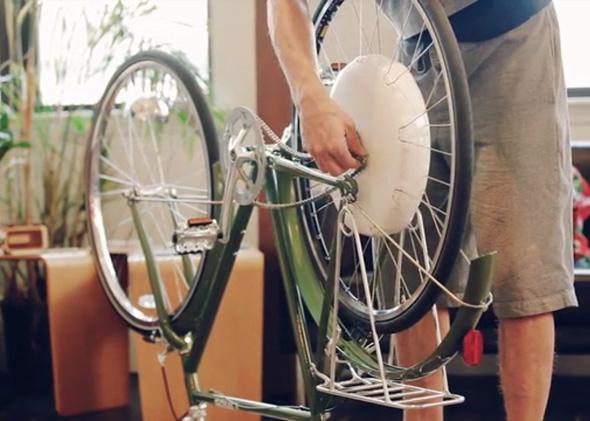This week, Slate is reviewing all the “smart” gizmos we can get our hands on. Read all the entries here.
Biking to work is hard for Americans, even for those who live in a relatively bike-friendly city. On any given commute, you may find yourself pedaling for your life as some motorist obliviously bears down on you. Then there are the ones who tailgate you, honking, as though you’re blocking the lane out of malice as opposed to pumping your poor legs as hard as you know how. You arrive at work fatigued and sweat-stained—not the most auspicious way to start a day.
Niko Klansek, a 29-year-old New Yorker and native Slovenian, is not a small man: He came to the United States to play college basketball, and he looks the power-forward part. Still, when he started a smoothie company in New York and tried to get around by bike, he would often arrive at meetings with distributors and suppliers dripping with sweat. “They didn’t take me seriously,” Klansek says. They assumed he was a bike messenger, not a businessman.
The solution, he decided, was an electric bike. But those on the market at the time were big, heavy, and pricey—more like mopeds than bikes, he says. So he pivoted from smoothies to starting his own electric-bike shop, called FlyKly. Business has been good, he says, but Klansek remained restless to improve on the electric-bike concept. Eventually he hit on a new idea: Rather than building electric bikes from the ground up, he would just build an electric rear wheel that people could attach to the bicycle they already own.

Screenshot courtesy of FlyKly Smart Wheel/Kickstarter
You operate the FlyKly Smart Wheel via an iPhone or Android app, telling it how fast you’d like to go. (The top speed is 20 mph.) As soon as you start pedaling, the electric assist kicks in and pushes you up to your cruising speed. To maintain the speed, you have to keep pedaling, but there’s hardly any resistance: It’s like riding an exercise bike on the easiest setting. Let off the pedals, and the electric assist cuts out, so you can coast or apply the brakes. The battery recharges when you go downhill, so that you can go up to 30 miles without recharging. And a special holder can recharge your mobile-phone battery using the energy from your front wheel as you ride along.
Drawing on revenues from his existing bike business, Klansek enlisted a team of designers, software developers, and engineers and got to work on the smart wheel. A crowdfunding campaign on Kickstarter was a smashing success. With a goal of $100,000, FlyKly brought in more than $700,000 from more than 2,000 backers.
On a balmy fall day, Klansek offered me a chance to try out his latest prototype of the smart wheel, which he hopes to begin shipping this spring. I wasn’t allowed to set the speed myself—for liability reasons, he said, he had it set well below the top speed for trial runs. I found this unfortunate, but then again, if I were Klansek, I’d probably be worried about random journalists steering into the bushes, too. Still, the bike accelerated smoothly and steadily, and riding it was a breeze. Gliding effortlessly past a fellow cyclist on a mild incline felt a little like cheating, but not in a bad way.
I had been concerned about trying to fiddle with the iPhone controls while riding, but on my brief test ride I found you don’t necessarily have to. If you commute regularly, you probably have a good idea in advance of what your cruising speed ought to be. And if you don’t, you can always pull over and adjust it. (The mobile-phone app is also supposed to come with an array of fancy smart features, like data-analytics tools that can track your ride and help you plan out better routes, but I didn’t have enough time with the bike to try them out.)
One potential concern with any pricey bike gadget is security. An electric wheel would seem to cry out “Steal me” to opportunistic passersby. But Klansek believes he has this covered: The smart wheel locks when you’re not using it. Of course, a thief can still pick up the whole thing and cart it off somewhere—but then your mobile app will alert you that the bike is moving without you on it and will keep tabs on it via GPS sensors so you can track it down again.
The initial appeal of the FlyKly Smart Wheel could be limited by one simple fact: The biggest bike enthusiasts tend to be people who like the pedaling part. It’s the more casual cyclists—the ones not committed enough to put on Lycra and a helmet every morning—who might be enticed by the electric-assist functions. Klansek hasn’t decided on a retail price, but it seems likely that it will be upward of $500—still a lot less than a fully electric bike. And if Klansek and his team can deliver on all their promises, the market for smart bike wheels might prove to be much larger than it is today.
“We want to get as many people as possible on bikes,” Klansek tells me. The appeal of the smart bike wheel is that “you can dress for the destination and not the ride.”
